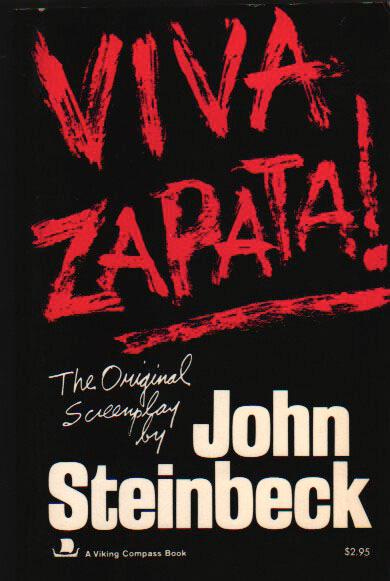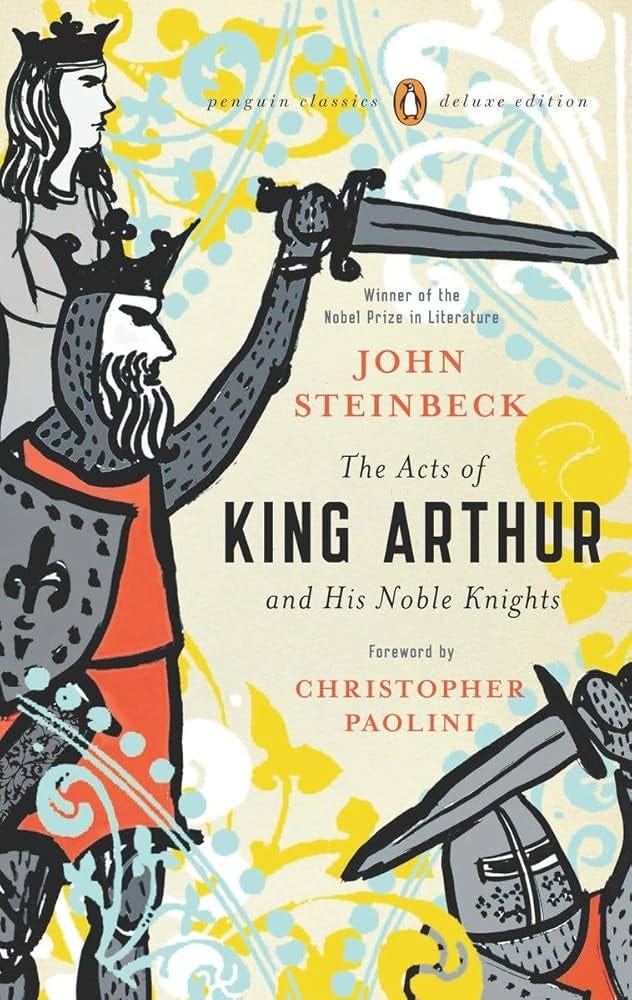The Steinbeck Review #9 - The Final Act
Travels with Charley | America and Americans | Viva Zapata | The Acts of King Arthur and his Nobel Knights
Exploring Life and Literature.
Dear friends,
In the twilight of his life, John Steinbeck became reflective on his personal journey as a writer and citizen. Several of his last books were nonfiction, a departure from the novels that made him famous. Travels With Charley and America and Americans were the last books published before his death. Viva Zapata was an original screenplay from 1952 that was later published in book format. The Acts of King Arthur and his Nobel Knights was published posthumously.
“What good is the warmth of summer, without the cold of winter to give it sweetness.”
Travels with Charley: In Search of America, published in 1962, is a travelogue that recounts Steinbeck’s road trip across the United States with his poodle, Charley. The book reflects his later-life perspectives and concerns while highlighting ordinary people's lives. As Steinbeck travels through different regions of America, he interacts with various people, capturing their stories, thoughts, and the essence of American life.
Like much of Steinbeck’s writing, this book is rich in social commentary. He reflects on the changes he observes in America, from urbanization and consumerism to racial tensions and the loss of regional identities. This aligns with his broader interest in exploring societal issues. The book is more personal and introspective than some of his earlier works. It offers insights into his thoughts and feelings as an older man reflecting on his life, country, and writing. This reflective tone differs somewhat from the more outwardly focused narratives of his earlier novels, but it is consistent with the deeper, more philosophical explorations found in works like The Winter of Our Discontent.
Travels with Charley was well-received by both critics and readers. Praised for its engaging prose, vivid descriptions, and thoughtful observations, many readers appreciated the blend of travel writing, social commentary, and personal reflection. However, some later critics questioned the accuracy of certain events described in the book, suggesting that Steinbeck may have embellished or fictionalized parts of his journey. Despite this, the book remains popular and a classic of American travel literature.
One of the book's central themes is the exploration of what it means to be American. Steinbeck examines the diverse cultures, attitudes, and landscapes that make up the country, questioning how they fit together into a national identity. He also reflects on the changes he observes in America, often with a sense of nostalgia for a simpler, more authentic past. He comments on the impact of modernization, urban sprawl, and the homogenization of culture, themes that resonate with his broader concern for the direction of American society.
Steinbeck's journey is both physical and spiritual as he seeks to reconnect with the country he feels he has lost touch with. Through his interactions with the people he meets and his own introspective musings, he explores the theme of isolation versus connection. The book also touches on the theme of nature and the open road as sources of freedom and inspiration. Steinbeck’s love of the natural world and his sense of adventure are evident throughout his travels.
This book fits well within Steinbeck’s literary style, focusing on social observation, the lives of ordinary people, and introspective reflection. It was well-received for its engaging narrative and thoughtful exploration of American life. The themes of American identity, change, and the quest for connection are central to the work, making it a significant part of Steinbeck’s legacy.
“We give the President more work than a man can do, more responsibility than a man should take, more pressure than a man can bear. We abuse him often and rarely praise him. We wear him out, use him up, eat him up.”
America and Americans, published in 1966, is one of Steinbeck's last works. It is a collection of essays that offer a deep and reflective examination of American society, culture, and identity. Readers recognized Steinbeck's keen social observations and critiques in novels like The Grapes of Wrath and The Winter of Our Discontent. This book continues this tradition, providing a critical yet affectionate analysis of the American people and their values. Steinbeck tackles issues such as racism, materialism, and the loss of community, themes that are consistent with his broader literary focus.
Despite its critical tone, Steinbeck's book reflects his characteristic empathy for ordinary people. He examines the contradictions and complexities of American life with a deep understanding of human nature, a hallmark of his style across his fiction and nonfiction. Similar to Travels with Charley, America and Americans is reflective and philosophical, revealing Steinbeck's thoughts and feelings about his country in his later years. This introspective approach aligns with the personal and moral concerns that increasingly characterized his writing in his later years. This collection demonstrates his ability to craft vivid, evocative prose. His detailed and engaging descriptions of American landscapes, both physical and cultural, showcase his talent for capturing the essence of a place or idea.
America and Americans received a mixed reception upon its release. Some praised it for its insightful and candid exploration of American life, appreciating Steinbeck's willingness to tackle complex and controversial issues. However, others felt the essays were disjointed and lacked the narrative cohesion of his earlier works. Over time, the book has been recognized as a valuable window into Steinbeck's views on America, especially as it reflects the social and cultural tensions of the 1960s.
The book's central theme is the exploration of what it means to be American. Steinbeck reflects on the diversity and contradictions inherent in the American identity, examining how the country's ideals often clash with its realities. Continuing the themes of his earlier works, Steinbeck addresses issues of social justice, particularly racial inequality and economic disparity. He critiques how America has failed to live up to its founding principles of equality and justice for all. Steinbeck is critical of the increasing materialism and consumerism he observes in American society. He argues pursuing wealth and possessions has led to a decline in moral and spiritual values, a concern that echoes his earlier critiques in novels like The Winter of Our Discontent.
The essays grapple with the concept of the American Dream, questioning whether it is still attainable or even desirable in its current form. Steinbeck examines how the dream has evolved and what it means for different people in different parts of the country. The book also explores the theme of change in terms of America's physical landscape and its cultural and social dynamics. Steinbeck reflects on the changes he has witnessed over his lifetime and the enduring qualities of the American spirit. This book is a reflective, critical, and ultimately empathetic examination of American life, fitting well within Steinbeck's broader literary style.
“Its better to die on your feet than to live on your knees.”
Viva Zapata! is a film script written in 1952 for a movie directed by Elia Kazan, starring Marlon Brando as Emiliano Zapata, the Mexican revolutionary leader. While it is not a book but a screenplay, it still fits within Steinbeck’s broader literary style and thematic concerns.
Like most of Steinbeck’s works, Viva Zapata! centers on the struggles of the marginalized and oppressed. Steinbeck had a long-standing interest in social justice and the plight of the downtrodden, prominent themes in The Grapes of Wrath and In Dubious Battle. These concerns manifest here in the story of a revolutionary fighting for land reform and the rights of the poor in Mexico. Steinbeck's emphasis on character development is evident in his portrayal of Emiliano Zapata, who is not just a historical figure but a complex character with personal conflicts and moral dilemmas, consistent with Steinbeck's style of creating multi-dimensional protagonists.
Steinbeck often explored his characters' moral and ethical dilemmas, and Viva Zapata! is no exception. The screenplay delves into Zapata's internal struggles with power, leadership, and his commitment to the revolution, reflecting Steinbeck's ongoing interest in the complexity of human nature and the consequences of individual choices. This work clearly expresses his views on revolution, justice, and the abuse of power. It also reflects Steinbeck's belief in the importance of social reform and his skepticism of authority, recurrent themes in his literary oeuvre.
The film was well-received by both audiences and critics, particularly for its convincing performances, especially by Marlon Brando, and its powerful narrative. The film was nominated for multiple Academy Awards, and Steinbeck's screenplay was praised for its compelling depiction of Zapata as a tragic hero. However, some critics and historians took issue with the film's historical accuracy, noting that certain events and characters were fictionalized or dramatized for cinematic effect.
The primary theme of Viva Zapata! is revolution and the quest for social justice. The screenplay examines the motivations behind the Mexican Revolution and the challenges of achieving meaningful change in a society plagued by corruption and inequality. It also explores the corrupting influence of power. As Zapata rises to a leadership position, he becomes increasingly aware of the dangers of authority and the ease with which revolutionary ideals can be compromised.
The story of Emiliano Zapata is also one of heroism and sacrifice. Steinbeck portrays Zapata as a man willing to give up everything, including his life, for the cause he believes in. This theme of personal sacrifice for the greater good is one that resonates with Steinbeck's broader body of work. The tension between individual desires and collective needs is another key theme. Zapata's personal struggles are set against the backdrop of a broader revolutionary movement, highlighting the complex interplay between individual agency and collective action.
“I have seen too many men go down, and I never permit myself to forget that one day, through accident or under the charge of a younger, stronger knight, I too will go down.”
The Acts of King Arthur and His Noble Knights John Steinbeck's retelling of the Arthurian legends, specifically drawing from Sir Thomas Malory’s Le Morte d'Arthur. Published after his death, this work is unique within Steinbeck’s bibliography. This work was a deeply personal project for Steinbeck. He had a lifelong interest in the Arthurian legends and saw this adaptation as a way to connect with the mythic roots of Western storytelling. The book was left unfinished at his death, which suggests it was a project he grappled with deeply, much like some of his more introspective works.
Although set in a mythic past, Steinbeck’s retelling of the Arthurian legends reflects his deep interest in human nature. The characters in the legends, especially King Arthur and his knights, are portrayed with the complexity and moral ambiguity that Steinbeck often used to depict his protagonists. Steinbeck was always fascinated by moral and ethical dilemmas, which are also central to the Arthurian legends. The themes of honor, loyalty, betrayal, and the struggle between good and evil are explored in a manner consistent with Steinbeck’s interest in the moral choices that define human life.
Steinbeck’s prose in this novel is more formal and archaic compared to his other works, reflecting the medieval setting of the stories. However, his ability to bring characters to life and his focus on the emotional and psychological dimensions of the narrative remains consistent with his style in more modern settings.
The book was published posthumously in 1976, eight years after Steinbeck’s death. The reception was mixed. Some critics appreciated Steinbeck's retelling's ambition and literary quality, noting his respect for the original material and his ability to infuse it with his unique voice. Others, however, felt that the work lacked the vitality and immediacy of his other novels. The book’s unfinished nature left some readers with a sense of incompleteness, though it also added to the mystique surrounding the project.
The Arthurian legends are centered around the ideals of justice, honor, and chivalry, themes that Steinbeck explores deeply. The knights’ quests and moral challenges reflect Steinbeck’s concerns with ethical behavior and social justice. He portrays the knights, including King Arthur himself, as deeply human, with flaws and vulnerabilities. This theme of the fallibility of heroes aligns with Steinbeck’s broader exploration of human imperfection and the complexities of heroism.
Steinbeck delves into the aspects of loyalty and betrayal, with his usual focus on the consequences of personal and moral choices. The relationships between the knights and Lancelot and Guinevere's ultimate betrayal of Arthur are explored with sensitivity to the emotional and ethical dimensions of these actions. The decline of Camelot and the end of the Arthurian age reflect a theme of loss and disillusionment, which is also present in some of Steinbeck’s other works. This can be seen as a reflection of Steinbeck’s own concerns about the changes he witnessed in American society during his lifetime.
recently shared John Steinbeck’s Six Tips to Good Writing.
Beyond the Bookshelf is a reader-supported publication. If you have the means and desire, please consider upgrading to a paid subscription.
Until next time,
Previous articles in this series:
If you are a new subscriber or missed any of the previous articles in this series, you can catch up at the links below:
All opinions in this essay are my own. Any biographical or factual information was obtained through the references below:
Mad at the World: A Life of John Steinbeck by William Souder
John Steinbeck: A Biography by Jay Parini
John Steinbeck, Writer: A Biography by Jackson Benson
Steinbeck: A Life in Letters edited by Elaine Steinbeck and Robert Wallsten










"Steinbeck's journey is both physical and spiritual as he seeks to reconnect with the country he feels he has lost touch with." Wow...I bet a lot of us feel that way right about now. I remember reading Peter Jenkins "A Walk Across America" during a time I felt thoroughly disillusioned with my life and felt a deep-seated fear of strangers. Reading his book really helped me become more open to people and see them as those who wanted the same things I did...to be loved by friends and family and to do good in the world. This book of Steinbeck's may be just the ticket for a time such as this.
Thank you Matthew. This makes me appreciate Steinbeck, and you, all the more.